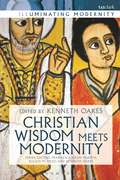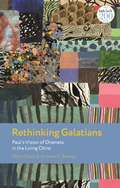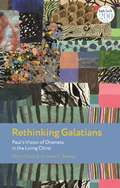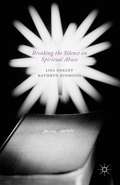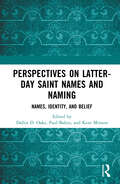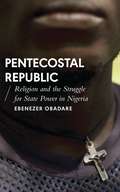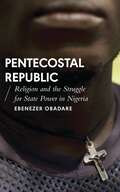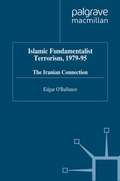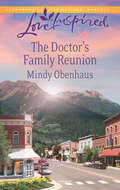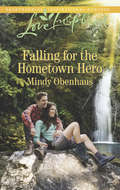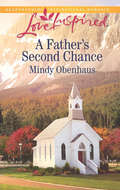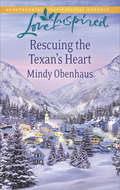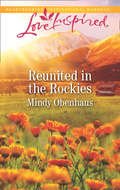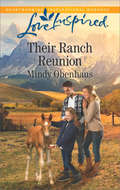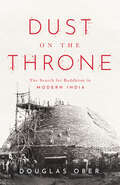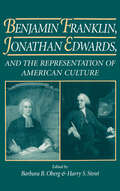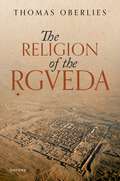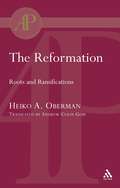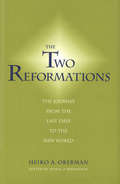- Table View
- List View
Christian Wisdom Meets Modernity (Illuminating Modernity)
by Kenneth OakesThe 'Illuminating Modernity' series examines the great but lesser known thinkers in the 'Romantic Thomist' tradition such as Erich Przywara and Fernand Ulrich and shows how outstanding 20th century theologians like Ratzinger and von Balthasar have depended on classical Thomist thought, and how they radically reinterpreted this thought. The chapters in this volume are dedicated to the encounter between the presuppositions and claims of modern intellectual culture and the Christian confession that the crucified and resurrected Jesus is the power and wisdom of God and is the lord of history and of his church.The scholars contributing to this discussion do not assume that Christianity and modernity are two discrete entities which can be readily defined, nor do they presume that Christian wisdom and modernity meet each other only in conflict or by coincidence. They engage with a variety of great figures – Kierkegaard, Heidegger, Rahner, Przywara, Guardini, Karl Barth, and Karol Wojtyla – to illustrate the connection between modernism and Christian wisdom. The volume concludes with a programmatic statement for the renewal of Christian philosophy that has been able to retain the cosmo-theological vision as outlined by Mezei in the final chapter.
Rethinking Galatians: Paul’s Vision of Oneness in the Living Christ
by Peter Oakes Andrew K. BoakyeOakes and Boakye rethink Galatians by examining the text as a vision for the lives of its hearers. They show how, in tackling the difficulties that he faces in Galatia, Paul offers a vision of what the Galatians are in their relationship with the living Christ. This offers a new understanding of the concept of unity in diversity expressed in Gal 3:28.The authors develop their views over six chapters. First, Oakes maps a route from the letter to a focus on its Galatian hearers and on Paul's vision for their identity and existence. In the next chapter, Oakes uses the Christology of Galatians as a way to support the idea of pistis as current relationship with the living Christ. Boakye then offers three chapters analysing the letter's scriptural quotations and ideas about salvation and law. Boakye sees a key dynamic at work in Galatians as being a movement from death to life, as prophesied metaphorically by Ezekiel and as made literal for Paul in his encounter with the resurrected Christ, trust in whom becomes the route to life. Life becomes a key category for evaluating law. Boakye also draws Galatians close to Romans 4 in seeing in both texts the promise of the birth of Isaac, with Paul closely tying that to the resurrection of Jesus. Oakes then argues that the letter has a thematic concern for unity in diversity. In the first instance this is between Jews and gentiles but, in principle, it is between any other socially significant pair of groups.
Rethinking Galatians: Paul’s Vision of Oneness in the Living Christ
by Peter Oakes Andrew K. BoakyeOakes and Boakye rethink Galatians by examining the text as a vision for the lives of its hearers. They show how, in tackling the difficulties that he faces in Galatia, Paul offers a vision of what the Galatians are in their relationship with the living Christ. This offers a new understanding of the concept of unity in diversity expressed in Gal 3:28.The authors develop their views over six chapters. First, Oakes maps a route from the letter to a focus on its Galatian hearers and on Paul's vision for their identity and existence. In the next chapter, Oakes uses the Christology of Galatians as a way to support the idea of pistis as current relationship with the living Christ. Boakye then offers three chapters analysing the letter's scriptural quotations and ideas about salvation and law. Boakye sees a key dynamic at work in Galatians as being a movement from death to life, as prophesied metaphorically by Ezekiel and as made literal for Paul in his encounter with the resurrected Christ, trust in whom becomes the route to life. Life becomes a key category for evaluating law. Boakye also draws Galatians close to Romans 4 in seeing in both texts the promise of the birth of Isaac, with Paul closely tying that to the resurrection of Jesus. Oakes then argues that the letter has a thematic concern for unity in diversity. In the first instance this is between Jews and gentiles but, in principle, it is between any other socially significant pair of groups.
Breaking the Silence on Spiritual Abuse
by L. Oakley K. KinmondProviding a balance of empirical research and practical concerns, this book explores the definitions and historical context of spiritual abuse, outlines a process model for the different stages of spiritual abuse and includes strategies for therapists working with survivors of spiritual abuse.
Perspectives on Latter-day Saint Names and Naming: Names, Identity, and Belief
by Dallin D. Oaks Paul Baltes Kent MinsonPerspectives on Latter-day Saint Names and Naming approaches cultural, historical, and doctrinal dimensions of The Church of Jesus Christ of Latter-day Saints through a fresh lens that explores how these dimensions intersect with names and naming. Featuring a collection of chapters from multiple authors, its bipartite structure examines fascinating topics in relation to the Church, looking first at cultural and historical perspectives before analyzing doctrinal and scriptural perspectives. The book discusses such matters as how contemporary naming practices of Latter-day Saints compare to those outside the faith, how code names were used in one of the faith’s books of scripture to protect Church leaders from persecution, and how names and naming relate to the covenant identity of Church members. Through its fresh approach to understanding religious identity and belief in relation to The Church of Jesus Christ of Latter-day Saints, this book is an invaluable resource for scholars and students of Mormon studies and will also be of interest to people with a fascination with names and naming issues as those occur in a variety of settings, including religious ones.
Perspectives on Latter-day Saint Names and Naming: Names, Identity, and Belief
by Dallin D. Oaks Paul Baltes Kent MinsonPerspectives on Latter-day Saint Names and Naming approaches cultural, historical, and doctrinal dimensions of The Church of Jesus Christ of Latter-day Saints through a fresh lens that explores how these dimensions intersect with names and naming. Featuring a collection of chapters from multiple authors, its bipartite structure examines fascinating topics in relation to the Church, looking first at cultural and historical perspectives before analyzing doctrinal and scriptural perspectives. The book discusses such matters as how contemporary naming practices of Latter-day Saints compare to those outside the faith, how code names were used in one of the faith’s books of scripture to protect Church leaders from persecution, and how names and naming relate to the covenant identity of Church members. Through its fresh approach to understanding religious identity and belief in relation to The Church of Jesus Christ of Latter-day Saints, this book is an invaluable resource for scholars and students of Mormon studies and will also be of interest to people with a fascination with names and naming issues as those occur in a variety of settings, including religious ones.
Pentecostal Republic: Religion and the Struggle for State Power in Nigeria (African Arguments)
by Ebenezer ObadareThroughout its history, Nigeria has been plagued by religious divisions. Tensions have only intensified since the restoration of democracy in 1999, with the divide between Christian south and Muslim north playing a central role in the country's electoral politics, as well as manifesting itself in the religious warfare waged by Boko Haram.Through the lens of Christian–Muslim struggles for supremacy, Ebenezer Obadare charts the turbulent course of democracy in the Nigerian Fourth Republic, exploring the key role religion has played in ordering society. He argues the rise of Pentecostalism is a force focused on appropriating state power, transforming the dynamics of the country and acting to demobilize civil society, further providing a trigger for Muslim revivalism.Covering events of recent decades to the election of Buhari, Pentecostal Republic shows that religio-political contestations have become integral to Nigeria's democratic process, and are fundamental to understanding its future.
Pentecostal Republic: Religion and the Struggle for State Power in Nigeria (African Arguments)
by Ebenezer ObadareThroughout its history, Nigeria has been plagued by religious divisions. Tensions have only intensified since the restoration of democracy in 1999, with the divide between Christian south and Muslim north playing a central role in the country's electoral politics, as well as manifesting itself in the religious warfare waged by Boko Haram.Through the lens of Christian–Muslim struggles for supremacy, Ebenezer Obadare charts the turbulent course of democracy in the Nigerian Fourth Republic, exploring the key role religion has played in ordering society. He argues the rise of Pentecostalism is a force focused on appropriating state power, transforming the dynamics of the country and acting to demobilize civil society, further providing a trigger for Muslim revivalism.Covering events of recent decades to the election of Buhari, Pentecostal Republic shows that religio-political contestations have become integral to Nigeria's democratic process, and are fundamental to understanding its future.
Islamic Fundamentalist Terrorism, 1979-95: The Iranian Connection
by E. O'BallanceThe Iranian Connection is the network of embassies and diplomatic staffs spread throughout the world that support Islamic Fundamentalist terrorism, controlled by 'Dept 15', in Tehran, the Iranian government denying all implication. When he came to power in 1979, Ayatollah Khomeini used terrorism to consolidate his position, realised its potential, and exploited it to further his dream to 'March to Jerusalem', by assassinating his enemies, supporting like-minded national terrorist groups, causing huge explosions at Israeli embassies, organising aircraft hijacking and hostage-taking. The Iranian Connection is supporting insurrection in Algeria and the Israeli Occupied Territories, the object being to install governments that will rule according to the Koran and Muslim custom.
The Deputy's Holiday Family: Her Amish Christmas Sweetheart The Rancher's Christmas Bride The Deputy's Holiday Family (Rocky Mountain Heroes #2)
by Mindy ObenhausA Family for Christmas
The Doctor's Family Reunion (Mills And Boon Love Inspired Ser.)
by Mindy ObenhausFamily means everything to Dr. Trent Lockridge.
Falling For The Hometown Hero: Her Rancher Bodyguard Lakeside Sweetheart Falling For The Hometown Hero (Mills And Boon Love Inspired Ser.)
by Mindy ObenhausThe Soldier’s Second Chance
A Father's Second Chance: Rancher Daddy Loving The Country Boy A Father's Second Chance (Mills And Boon Love Inspired Ser.)
by Mindy ObenhausRepairing Her Heart
Her Colorado Cowboy: The Amish Spinster's Courtship The Rancher's Legacy Her Colorado Cowboy (Rocky Mountain Heroes #3)
by Mindy ObenhausLassoing the single Mum's heart…
Rescuing the Texan's Heart: Her Hometown Hero The Deputy's New Family Rescuing The Texan's Heart (Mills And Boon Love Inspired Ser.)
by Mindy ObenhausMELTING HIS HEART
Reunited In The Rockies: Rocky Mountain Heroes (Rocky Mountain Heroes #4)
by Mindy ObenhausA fresh start…and an old love reignited? A Rocky Mountain Heroes romance
Dust on the Throne: The Search for Buddhism in Modern India (South Asia in Motion)
by Douglas OberReceived wisdom has it that Buddhism disappeared from India, the land of its birth, between the thirteenth and fourteenth centuries, long forgotten until British colonial scholars re-discovered it in the early 1800s. Its full-fledged revival, so the story goes, only occurred in 1956, when the Indian civil rights pioneer Dr. B.R. Ambedkar converted to Buddhism along with half a million of his Dalit (formerly "untouchable") followers. This, however, is only part of the story. Dust on the Throne reframes discussions about the place of Buddhism in the subcontinent from the early nineteenth century onwards, uncovering the integral, yet unacknowledged, role that Indians played in the making of modern global Buddhism in the century prior to Ambedkar's conversion, and the numerous ways that Buddhism gave powerful shape to modern Indian history. Through an extensive examination of disparate materials held at archives and temples across South Asia, Douglas Ober explores Buddhist religious dynamics in an age of expanding colonial empires, intra-Asian connectivity, and the histories of Buddhism produced by nineteenth and twentieth century Indian thinkers. While Buddhism in contemporary India is often disparaged as being little more than tattered manuscripts and crumbling ruins, this book opens new avenues for understanding its substantial socio-political impact and intellectual legacy.
Dust on the Throne: The Search for Buddhism in Modern India (South Asia in Motion)
by Douglas OberReceived wisdom has it that Buddhism disappeared from India, the land of its birth, between the thirteenth and fourteenth centuries, long forgotten until British colonial scholars re-discovered it in the early 1800s. Its full-fledged revival, so the story goes, only occurred in 1956, when the Indian civil rights pioneer Dr. B.R. Ambedkar converted to Buddhism along with half a million of his Dalit (formerly "untouchable") followers. This, however, is only part of the story. Dust on the Throne reframes discussions about the place of Buddhism in the subcontinent from the early nineteenth century onwards, uncovering the integral, yet unacknowledged, role that Indians played in the making of modern global Buddhism in the century prior to Ambedkar's conversion, and the numerous ways that Buddhism gave powerful shape to modern Indian history. Through an extensive examination of disparate materials held at archives and temples across South Asia, Douglas Ober explores Buddhist religious dynamics in an age of expanding colonial empires, intra-Asian connectivity, and the histories of Buddhism produced by nineteenth and twentieth century Indian thinkers. While Buddhism in contemporary India is often disparaged as being little more than tattered manuscripts and crumbling ruins, this book opens new avenues for understanding its substantial socio-political impact and intellectual legacy.
Benjamin Franklin, Jonathan Edwards, And The Representation Of American Culture
by Barbara B. Oberg Harry S. StoutBenjamin Franklin, Jonathan Edwards, and the Representation of American Culture
by Barbara B. Oberg Harry S. StoutThis interdisciplinary collection of comparative essays by distinguished historians and literary critics looks at aspects of the thought of Jonathan Edwards and Benjamin Franklin and considers the place of these two men in American culture. Probably the two most examined figures of the colonial period, they have often been the object of comparative studies. These characterizations usually portray them as mutually exclusive ideal types, thus placing them in categories as different and opposed as "traditional" and "modern." In these essays--by such scholars as William Breitenbach, Edwin Gaustad, Elizabeth Dunn, and Ruth Bloch--polemical contrasts disappear and Edwards and Franklin emerge as contrapuntal themes in a larger unity. Benjamin Franklin, Jonathan Edwards, and the Representation of American Culture is a valuable addition to scholarship on American literature and thought.
The Religion of the Rigveda
by Thomas OberliesThis comprehensive new presentation of the religion of the Rigveda is the result of a thorough-going endeavour to extrapolate historical circumstances from that literary text and present them chiefly from the perspective of the adherents to this religion. For them society, social life, and religion were inextricably bound. This helps to explain the meanings of rights and rituals. Which rituals are to be performed at what times is influenced by the way of life of these Vedic tribes which alternates between peaceful settling and predatory raids. The 'priests' who carry out the rituals embody the gods of the Rigvedic pantheon. In telling the story of these rituals, Thomas Oberlies highlights particular connections — such as the association of the war god Indra with the priest who recites the hymns which invite the gods — that help us solve many of the riddles which the text of the Rigveda still poses to this day. The Religion of the Rigveda includes a wealth of quotations from primary sources which form the basis of this approach to a religion that would later become Hinduism. A comprehensive index of subjects makes the book eminently accessible for use in further studies.
The Religion of the Rigveda
by Thomas OberliesThis comprehensive new presentation of the religion of the Rigveda is the result of a thorough-going endeavour to extrapolate historical circumstances from that literary text and present them chiefly from the perspective of the adherents to this religion. For them society, social life, and religion were inextricably bound. This helps to explain the meanings of rights and rituals. Which rituals are to be performed at what times is influenced by the way of life of these Vedic tribes which alternates between peaceful settling and predatory raids. The 'priests' who carry out the rituals embody the gods of the Rigvedic pantheon. In telling the story of these rituals, Thomas Oberlies highlights particular connections — such as the association of the war god Indra with the priest who recites the hymns which invite the gods — that help us solve many of the riddles which the text of the Rigveda still poses to this day. The Religion of the Rigveda includes a wealth of quotations from primary sources which form the basis of this approach to a religion that would later become Hinduism. A comprehensive index of subjects makes the book eminently accessible for use in further studies.
The Reformation: Roots and Ramifications
by Heiko ObermanIn this wide-ranging volume Heiko Oberman traces threads of continuity flowing to and through the Reformation. Many his most important studies appear here in English for the first time.Professor Oberman explores "experiential" mysticism; the "battle on two fronts" waged by the Wittenburg circle against Pierias and Eck; Luther's medieval and apocalyptical conception of reformatio and its purpose; the pre-history of "confessionalization" in the Confession of Ausburg and its "Confutatio" byt Luther's Roman opponents; Zwingli's plans for a Godly alliance in the southern Germanic ecumene and the destructive tensions between Zwingli and Luther.In the final chapter, Oberman describes a model of three long-term "Reformations" that can also be seen as revolutions: the Concillar Reformation, the City Reformation, and the Calvinist Reformation of the Refugees. The often denied and generally misunderstood "continuities" between theological directions of the later Middle Ages, the theological reformation of the early sixteenth century and subsequent developments are constantly illuminated through exacting detail and compelling insights.
The Two Reformations: The Journey from the Last Days to the New World
by Professor Heiko A. ObermanIn this last collection of his vital, controversial, and accessible writings, Heiko A. Oberman seeks to liberate and broaden our understanding of the European Reformation, from its origins in medieval philosophy and theology through the Puritan settlers who brought Calvin’s vision to the New World. Ranging over many topics, Oberman finds fascinating connections between aspects of the Reformation and twentieth-century history and thought-most notably the connection to Nazism and the Holocaust. He revisits his earlier work on the history of anti-Semitism, rejects the notion of an unbroken line from Luther to Hitler to the Holocaust, and offers a new perspective on the Christian legacy of anti-Semitism and its murderous result in the twentieth century.Oberman demonstrates how the simplifications and rigidities of modern historiography have obscured the existential spirits of such great figures as Luther and Calvin. He explores the debt of both Luther and Calvin to medieval religious thought and the impact of diverse features of "the long fifteenth century”-including the Black Death, nominalism, humanism, and the Conciliar Movement-on the Reformation.
